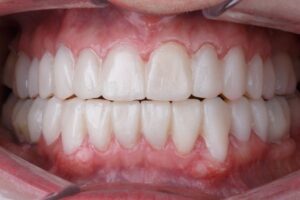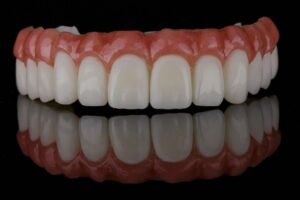Dental procedures can often feel overwhelming, especially when understanding the various treatments involved. One essential component that many patients may encounter is the temporary crown in San Antonio, TX.
This blog post will delve into temporary crowns, their types, procedures, advantages, disadvantages, care, and more.
Call me for any information at (210) 533-8191
“We value your feedback! If you’ve visited us, please take a moment to leave a review on our Google My Business page: Leave a Review. Your input helps us improve and serve you better!”
What is a Temporary Crown?
A temporary crown is a short-term dental restoration placed over a prepared tooth to protect it until a permanent crown is ready. It serves several essential functions, including shielding the tooth from damage, preserving its structure, and maintaining aesthetics and function while you wait for the final restoration.

A dental crown is a tooth-shaped cap that is placed on decayed and damaged teeth, covering the entire visible portion of the tooth above the gum line. It helps maintain the shape, size, and strength of your decayed tooth. We understand how important your beautiful dental smile and optimal dental health are.
Learn more about different types of crowns in our post on Dental Crowns vs Fillings.
Types of Temporary Crowns
Temporary crowns come in various types, primarily differentiated by the materials used:
- Acrylic Resin: This is one of the most common materials for temporary crowns. Acrylic crowns are lightweight, easy to shape, and can be quickly fabricated in a dental office.
- Composite Resin: These crowns offer a more natural appearance and can be matched to the color of your existing teeth. They are slightly more durable than acrylic but can still be prone to wear over time.
- Metal-Based Crowns: These are less common but may sometimes be used. They are more durable and can withstand significant bite forces, making them suitable for back teeth.
Temporary crowns can also be classified as either pre-fabricated or custom-made. Pre-fabricated crowns are standardized shapes that can be adjusted to fit, while custom-made crowns are crafted based on impressions of your tooth for a more precise fit.
Indications for Temporary Crowns
Temporary crowns are used in various scenarios, including:
- During Root Canals: After the dental pulp is removed, a temporary crown protects the tooth while waiting for a permanent crown.
- After Tooth Extractions: If a tooth is removed and a crown is needed on the adjacent tooth, a temporary crown can help maintain space and aesthetics.
- Before Permanent Crown Placement: After a tooth has been prepared for a crown, a temporary crown is often placed to protect it until the permanent crown is ready.
- For Damaged or Decayed Teeth: Temporary crowns can cover teeth that are significantly damaged or decayed, providing protection and function until a more permanent solution is available.

The Procedure for Temporary Crowns
Understanding the procedure for getting a temporary crown can help alleviate some anxiety. Here’s a step-by-step overview:
- Initial Consultation and Diagnosis: Your dentist will first evaluate your dental health and determine if a temporary crown is necessary. This may involve X-rays and a thorough examination.
- Tooth Preparation: The dentist will prepare the tooth once it’s decided that a crown is needed. This involves shaping the tooth to ensure a proper fit for the crown.
- Impressions: After shaping the tooth, the dentist will take impressions, which will be used to create a custom temporary crown if necessary.
- Crown Placement: The temporary crown is then placed over the prepared tooth. The dentist checks the fit and makes any necessary adjustments. It is usually secured with temporary cement, allowing for easy removal later.
Advantages of Temporary Crowns
Temporary crowns offer several benefits:
- Protection: They safeguard the prepared tooth from bacteria and damage.
- Aesthetics: Temporary crowns can improve the appearance of your smile while waiting for a permanent solution.
- Functionality: They allow you to chew and speak normally, maintaining your quality of life during the waiting period.
Disadvantages and Limitations
While temporary crowns are beneficial, they do come with some limitations:
- Durability: Temporary crowns are less intense than permanent crowns. They can wear down or break over time, especially if you chew hard foods.
- Displacement: Because they are not permanently cemented, the crown may become loose or dislodged.
- Sensitivity: Some patients may experience temperature or pressure sensitivity due to the nature of the temporary crown.
Care and Maintenance
Caring for a temporary crown is essential to ensure it lasts until your permanent crown is ready. Here are some tips:
- Hygiene Practices: Brush and floss gently around the temporary crown to maintain good oral hygiene. Be careful not to dislodge it during brushing.
- Dietary Recommendations:
- Foods to Avoid: Avoid sticky, hard, or chewy foods that could dislodge or damage the crown. These include chewing gum, hard candies, and raw vegetables.
- Eating Strategies: Try to chew on the opposite side of your mouth to minimize pressure on the temporary crown.
- Monitoring: Watch the temporary crown for any signs of discomfort, looseness, or changes in fit. If you notice any issues, contact your dentist promptly.
Duration of Use
Temporary crowns are designed for short-term use, typically lasting a few days to a few weeks. However, they can sometimes last longer, depending on individual circumstances and care. Your dentist will provide a timeline for when you should return for your permanent crown.
Transition to Permanent Crowns
When it’s time to transition to a permanent crown, your dentist will remove the temporary crown, assess the prepared tooth, and place the permanent crown. The permanent crown is usually made of more durable materials, providing a long-lasting solution for your dental needs.
Related article:
Conclusion
Temporary crowns play a crucial role in dental procedures, offering protection, aesthetics, and functionality during the interim period before a permanent solution is in place. While they have certain advantages and limitations, understanding their purpose and care can help you navigate the process confidently.

